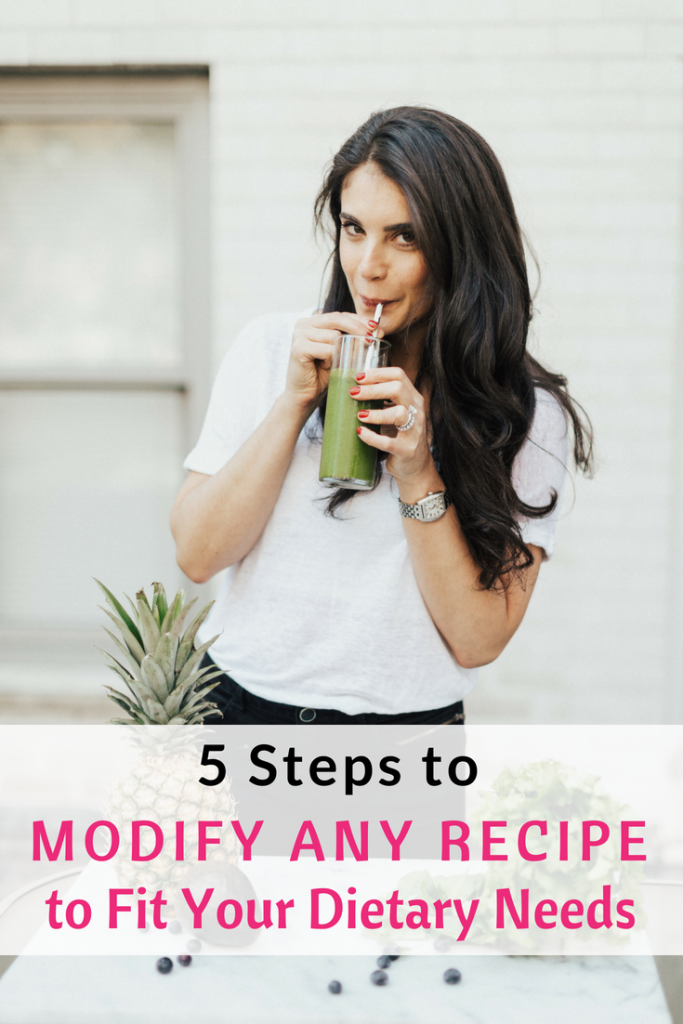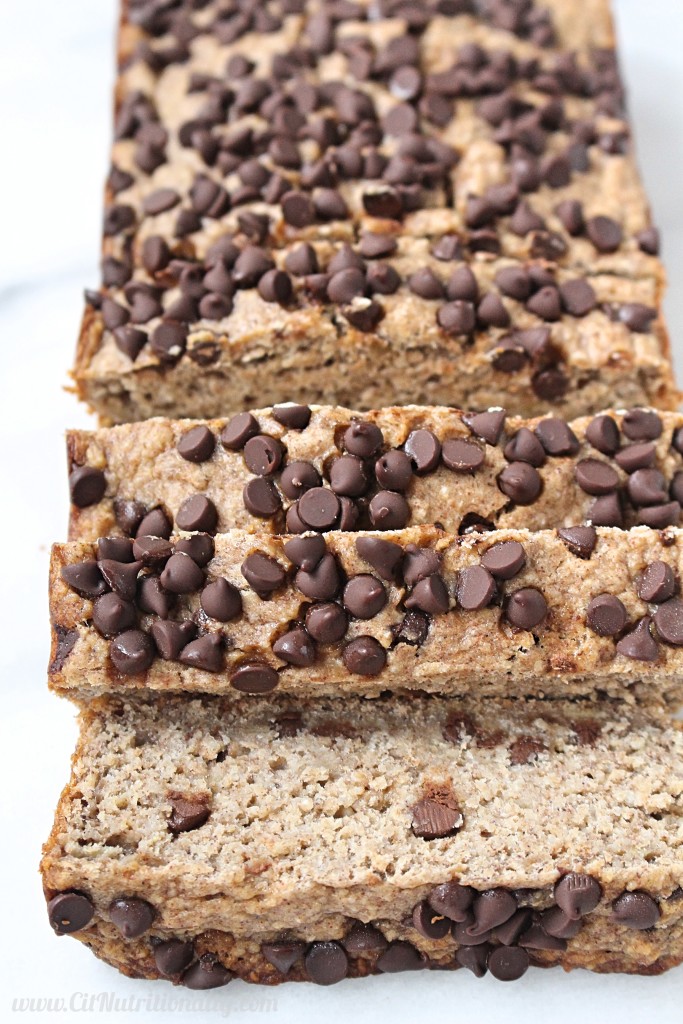5 Steps to Modify Any Recipe to Fit Your Dietary Needs
If you have food allergies, intolerances, or medically-necessary dietary restrictions, some of your favorite foods may all of a sudden be off-limits. Rest assured, there are easy ways you can modify any recipe to fit your dietary needs! I’ll show you how…
Having food allergies or intolerances is no walk in the park… but that doesn’t mean your meals have to be boring!
It’s so easy for those of us with food allergies, intolerances, or medically-necessary dietary restrictions, to feel deprived. And this is especially apparent around the holidays or food-centric gatherings (a la Labor Day!).
As we transition into fall, and the Jewish holidays approaching, it’ll be Halloween, Thanksgiving, Christmas and Chanukah before we know it! I figured it’s the perfect time to discuss how to modify ANY recipe to fit your dietary needs.
Although I truly believe that we should fit ALL foods in our diets, it’s not always the reality for many of us. Personally, I have life-threatening food allergies, but I work with individuals every day who have specific dietary restrictions that help their bodies feel their best.
If you’re not culinary-inclined, it can be hard to see how to make safe swaps in your recipes.
Can you cut the sugar in half and achieve the same consistency?
What’s a safe swap for eggs?
What about working with gluten free flours?
While each of these questions can even be a post on their own, today I want to share some general tips for adapting recipes to best fit your dietary needs… whether it’s a specific food allergy, intolerance, or dietary need (like reducing your added sugar intake).
I’m hoping that these 5 steps will actually help you LIBERALIZE your diet. After reading these 5 steps, I want you to be able to see a recipe with your allergen and feel confident that you know how to adapt it!
Sure, you could ask the recipe creator about substitutions, but speaking from experience as a recipe creator, they probably don’t know.
I spend hours creating, testing, tweaking, and re-testing recipes before I share them with you… but that doesn’t include every substitution out there!
Plus, if you use cookbooks, you may not be able to ask about substitutions!
It just takes some basic knowledge about cooking and baking to get started…
Here are 5 Steps to Modify Any Recipe to Fit Your Dietary Needs:
1. Choose 1 Adaptation to start
If you’re new to recipe makeovers, a good trick is to start slow.
Don’t try to make a recipe food allergy friendly, vegan, gluten free, salt-free, sugar-free, everything-free.
It won’t work (usually), right off the bat.
Instead, choose 1 adaptation at a time.
2. Focus On Flavor
Whether you’re trying to modify a recipe to make it a litttttle bit healthier, or to avoid a particular food allergen, my number one piece of advice is to make FLAVOR your priority. No one wants a free-from (insert whatever ingredient here) recipe devoid of deliciousness!
Here are some general guidelines:
If you’re reducing FAT (whether from egg yolks, butter, or oil), make sure there’s a creamy and moist substitution (like applesauce, avocado, or oil instead of butter).
Take my avocado brownies for example – I cut down the amount of oil added dramatically, but added avocado for added creaminess.
If you’re reducing sugar, make sure there’s something else to add natural sweetness.
It’s easy to reduce ADDED sugar, as long as there’s another source of NATURAL sweetness. Some of my favorite ways to add natural sweetness in recipes are:
- Bananas – check out my NO added sugar banana bread!
- Dates or date sugar
- Unsweetened cocoa powder
- Yogurt
- Pure vanilla extract or vanilla bean
If you’re eliminating gluten, be sure you research how gluten-free flours work!
Is it 1-to-1 like many gluten free flour blends, or different like coconut flour? Bookmark this guide if you’re ever questioning it!
3. Replace Wet Ingredients For Wet Ingredients, and Dry For Dry
OK, so maybe you don’t have all that much time for research. A good rule of thumb is to replace wet ingredients for wet ingredients and dry ingredients for dry… especially when baking!
For example, if you’re trying to reduce the oil in a brownie recipe, you may find unsweetened applesauce works well. They’re both of similar consistency.
Things get tricky, however, if I were to replace the sugar in this recipe with date paste, because dates are “wet,” but sugar is dry. This means that you may need to tweak the ratios of your other wet ingredients, or adjust the baking time and temperature, to achieve similar results.
4. Think outside of the box
Just because you’re following a recipe, doesn’t mean you need to follow it to a T.
I recently wrote an article for Sparkpeople about cooking healthier meals WITHOUT using a recipe, but if you’re still holding on, maybe taking some culinary freedom is a great 1st step.
This is especially true if you’re trying to “healthify” a recipe, as I like to say.
Here are some EASY reductions you can make to create a healthier recipe:
- Cut the oil in salad dressings to create a 1:1 ratio of oil and acid (ie: vinegar) instead of 2:1.
- Cut the sugar in a recipe by 1/4 cup – it usually won’t impact the end result.
- Reduce the amount of oil used when cooking vegetables – like roasting or sautéing.
- Use better quality ingredients than what’s called for. Swap out canola or vegetable oil in favor of avocado oil, olive oil, or coconut oil.
- Use fresh herbs and spices to add more flavor to recipes.
5. Understand the “job” of the ingredients you use
Eggs, flour, milk, oil… these ingredients don’t always play the same “role” in recipes.
For example, eggs can be used as emulsifiers, leavening agents, or play an important role in structure and stability. Therefore, if you’re trying to create an egg-free recipe, it’s essential to know what the “job” of eggs are in your recipe.
The same can be true of flour, oil, or any ingredient.
This isn’t always easy to decipher, but with practice you’ll get more comfortable.
[Tweet “Here are 5 Steps to Modify Any Recipe to Fit Your Dietary Needs >>>”]
So tell me… do you play around with recipes to make modifications? What “rules” do you use?
XO







 Hi there!
Thanks for stopping by! I'm Chelsey, an online Registered Dietitian, recipe developer, budding photographer, and coffee addict! My mission is to help you feel good through food by answering the question "What should I eat?" Let's make nutrition approachable!
I hope you enjoy my personal collection of simple, healthy, food allergy friendly and nutritiously delicious recipes, plus tips and tons of tricks that will help YOU live a nutritionally-balanced life! I look forward to getting to know you better...
Hi there!
Thanks for stopping by! I'm Chelsey, an online Registered Dietitian, recipe developer, budding photographer, and coffee addict! My mission is to help you feel good through food by answering the question "What should I eat?" Let's make nutrition approachable!
I hope you enjoy my personal collection of simple, healthy, food allergy friendly and nutritiously delicious recipes, plus tips and tons of tricks that will help YOU live a nutritionally-balanced life! I look forward to getting to know you better...







